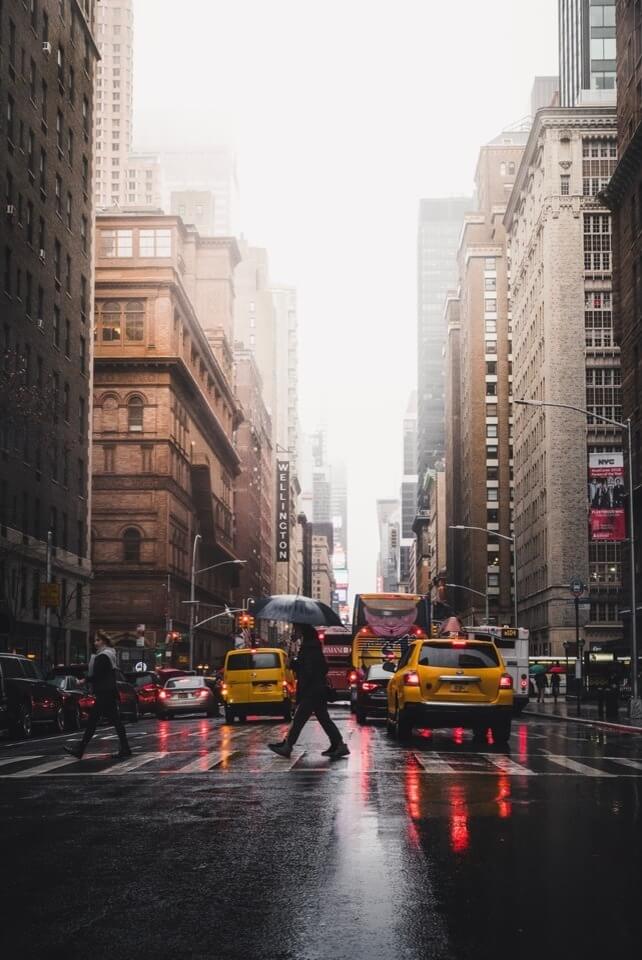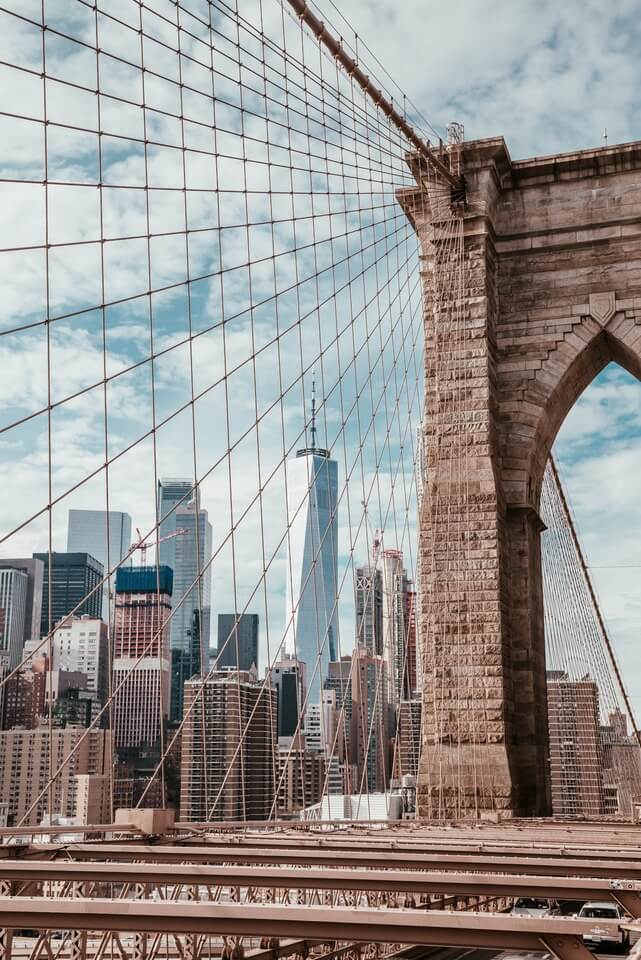New York is a state in the Northeastern and Mid-Atlantic regions of the United States. New York is the 27th-most extensive, the fourth-most populous, and the seventh-most densely populated of the 50 United States. New York is bordered by New Jersey and Pennsylvania to the south and Connecticut, Massachusetts, and Vermont to the east. The state has a maritime border with Rhode Island east of Long Island, as well as an international border with the Canadian provinces of Quebec to the north and Ontario to the west and north. The state of New York is often referred to as New York State or the State of New York to distinguish it from New York City, the state's most populous city and its economic hub.
“When I’m in New York, I just want to walk down the street and feel this thing, like I’m in a movie.” ― Ryan Adams
With a Census-estimated population of nearly 8.5 million in 2014, New York City is the most populous city in the United States. The city is the nucleus of the premier gateway for legal immigration to the United States — the New York City Metropolitan Area, one of the most populous urban agglomerations in the world. New York City is also known for being the location of Ellis Island, the largest historical gateway for immigration in the history of the United States. A global power city, New York City exerts a significant impact upon commerce, finance, media, art, fashion, research, technology, education, and entertainment. The home of the United Nations Headquarters, New York City is an important center for international diplomacy and has been described as the cultural and financial capital of the world, as well as the world's most economically powerful city.



New York City alone makes up over 40 percent of the population of New York State. Two-thirds of the state's population lives in the New York City Metropolitan Area, and nearly 40% live on Long Island. Both the state and New York City were named for the 17th century Duke of York, future King James II of England. The next four most populous cities in the state are Buffalo, Rochester, Yonkers, and Syracuse, while the state capital is Albany.
The earliest Europeans in New York were French colonists and Jesuit missionaries who arrived southward from settlements at Montreal for trade and proselytizing. New York had been inhabited by various tribes of Algonquian and Iroquoian-speaking Native Americans for several hundred years by the time Dutch settlers moved into the region in the early 17th century. In 1609, the region was first claimed by Henry Hudson for the Dutch, who built Fort Nassau in 1614 at the confluence of the Hudson and Mohawk rivers, where the present-day capital of Albany later developed. The Dutch soon also settled New Amsterdam and parts of the Hudson Valley, establishing the colony of New Netherland based on trade and profitmaking, a multicultural community from its earliest days and a center of trade and immigration. The British annexed the colony from the Dutch in 1664. The borders of the British colony, the Province of New York, were quite similar to those of the present-day state.
“I go to Paris, I go to London, I go to Rome, and I always say, There’s no place like New York. It’s the most exciting city in the world now. That’s the way it is. That’s it.” ― Robert De Niro
Many landmarks in New York are well known to both international and domestic visitors, with New York State hosting four of the world's ten most-visited tourist attractions in 2013: Times Square, Central Park, Niagara Falls (shared with Ontario), and Grand Central Terminal. New York is home to the Statue of Liberty, a symbol of the United States and its ideals of freedom, democracy, and opportunity. New York's higher education network comprises approximately 200 colleges and universities, including Columbia University, Cornell University, New York University, and Rockefeller University, which have been ranked among the top 35 in the world.
History
16th century
In 1524, Giovanni da Verrazzano, an Italian explorer in the service of the French crown, explored the Atlantic coast of North America between the Carolinas and Newfoundland, including New York Harbor and Narragansett Bay. On April 17, 1524 Verrazanno entered New York Bay, by way of the Strait now called the Narrows into the northern bay which he named Santa Margherita, in honour of the King of France's sister. Verrazzano described it as "a vast coastline with a deep delta in which every kind of ship could pass" and he adds: "that it extends inland for a league and opens up to form a beautiful lake. This vast sheet of water swarmed with native boats". He landed on the tip of Manhattan and perhaps on the furthest point of Long Island. Verrazanno's stay in this place was interrupted by a storm which pushed him north towards Martha's Vineyard.
In 1540 French traders from New France built a chateau on Castle Island, within present-day Albany; due to flooding, it was abandoned the next year. In 1614, the Dutch under the command of Hendrick Corstiaensen, rebuilt the French chateau, which they called Fort Nassau. Fort Nassau was the first Dutch settlement in North America, and was located along the Hudson River, also within present-day Albany. The small fort served as a trading post and warehouse. Located on the Hudson River flood plain, the rudimentary "fort" was washed away by flooding in 1617, and abandoned for good after Fort Orange (New Netherland) was built nearby in 1623.
17th century
Henry Hudson's 1609 voyage marked the beginning of European involvement with the area. Sailing for the Dutch East India Company and looking for a passage to Asia, he entered the Upper New York Bay on September 11 of that year. Word of his findings encouraged Dutch merchants to explore the coast in search for profitable fur trading with local tribes.
During the 17th century, Dutch trading posts established for the trade of pelts from the Lenape, Iroquois, and other tribes were founded in the colony of New Netherland. The first of these trading posts were Fort Nassau (1614, near present-day Albany); Fort Orange (1624, on the Hudson River just south of the current city of Albany and created to replace Fort Nassau), developing into settlement Beverwijck (1647), and into what became Albany; Fort Amsterdam (1625, to develop into the town New Amsterdam which is present-day New York City); and Esopus, (1653, now Kingston). The success of the patroonship of Rensselaerswyck (1630), which surrounded Albany and lasted until the mid-19th century, was also a key factor in the early success of the colony. The English captured the colony during the Second Anglo-Dutch War and governed it as the Province of New York. The city of New York was recaptured by the Dutch in 1673 during the Third Anglo-Dutch War (1672–1674) and renamed New Orange. It was returned to the English under the terms of the Treaty of Westminster a year later.
Geography
New York covers 54,555 square miles (141,300 km2) and ranks as the 27th largest state by size. The Great Appalachian Valley dominates eastern New York and contains the Lake Champlain Valley as its northern half and the Hudson Valley as its southern half within the state. The rugged Adirondack Mountains, with vast tracts of wilderness, lie west of the Lake Champlain Valley. The Hudson River begins near Lake Tear of the Clouds and flows south through the eastern part of the state without draining Lakes George or Champlain. Lake George empties at its north end into Lake Champlain, whose northern end extends into Canada, where it drains into the Richelieu River and then ultimately the Saint Lawrence River. Four of New York City's five boroughs are situated on three islands at the mouth of the Hudson River: Manhattan Island; Staten Island; and Long Island, which contains Brooklyn and Queens at its western end.
Most of the southern part of the state rests on the Allegheny Plateau, which rises from the southeastern United States to the Catskill Mountains; the section in New York State is known as the Southern Tier. The western section of the state is drained by the Allegheny River and rivers of the Susquehanna and Delaware River systems. The Delaware River Basin Compact, signed in 1961 by New York, New Jersey, Pennsylvania, Delaware, and the federal government, regulates the utilization of water of the Delaware system. The highest elevation in New York is Mount Marcy in the Adirondacks, at 5,344 ft (1,629 m) above sea level; while the state's lowest point is at sea level, on the Atlantic Ocean. [ Source ]

Member discussion